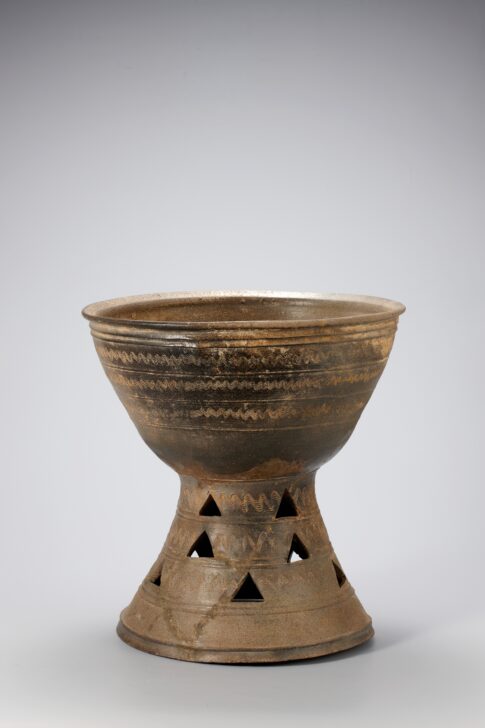Large Pedestal Bowl or Stand
Korean

Description
March 28, 2009
In southern Korea from the fifth through the sixth century, all imaginable types of pottery vessels—storage jars, bowls, drinking cups, oil lamps—were positioned high off the ground. Vessels with tall and hollow perforated pedestals like this were used either to hold food and drink or as a stand for a separate round-bottomed food container. Pedestals are found attached only to thin, high-fired stoneware—works at the cutting edge of contemporary technology—that were likely made for the elite class. This example shows a shiny grayish-green glaze created when kiln ash landed on its surface and vitrified during the firing process.
---
In southern Korea from the fifth through the sixth century, all imaginable types of pottery vessels—storage jars, bowls, drinking cups, oil lamps—were positioned high off the ground. Vessels with tall and hollow perforated pedestals like this were used either to hold food and drink or as a stand for a separate round-bottomed food container. Pedestals are found attached only to thin, high-fired stoneware—works at the cutting edge of contemporary technology—that were likely made for the elite class. This example shows a shiny grayish-green glaze created when kiln ash landed on its surface and vitrified during the firing process. Pedestal pots with parallel bands of cutouts tend to originate from the Gaya states, while those with alternating rows of openings are more common to Silla.
(Label for UMMA Korean Gallery Opening Rotation, March 2009)
Subject Matter:
Used to hold food or drink, or a larger round-bottomed storage container.
Footed bowl was found in the Three Kingdom and Unified Silla. It is one of the ritual vessels. It can be found in every tomb of that age. It is almost grayish-blue stoneware. At the beginning, It didn’t have lid and perforation. From 4C lid and perforation was made. Footed bowl is divided Silla style and Gaya style. The lid and bowl of Silla style are thick and the leg is slim. The perforation is located in altering position. In contrast, the lid and bowl of Gaya style is very flat and the leg is thick. The perforation is positioned in parallel.
Physical Description:
Large pedestal bowl with flaring mouth and base cut with evenly spaced triangular designs. Three side-by-side horizontal bands decorate the lip of the bowl, while six bands are spaced along the sides encompass the exterior of the bowl. In between these bands incised wavy lines stretch around the body horizontally.
This is a well-fired, dark gray, bowl-shaped vessel stand. A set of two thick raised bands encircles the stand just below the rim, and three horizontal ridges divide the surface of the bowl below the bands. The sections divided by these bands and ridges have been decorated with wave designs rendered using a four-tooth comb. The bowl has an everted mouth and a round rim. The pedestal is also divided by raised bands into sections decorated with wave designs. Each of the upper two sections features five triangular perforations, while the lower sections feature five triangular perforations alternately offset from those of the sections above. The inner and outer surfaces show faint traces of natural glaze.
[Korean Collection, University of Michigan Museum of Art (2017) p. 54]
Usage Rights:
If you are interested in using an image for a publication, please visit https://umma.umich.edu/request-image/ for more information and to fill out the online Image Rights and Reproductions Request Form.